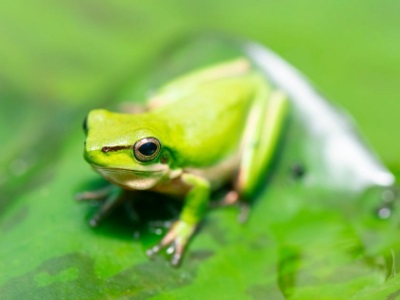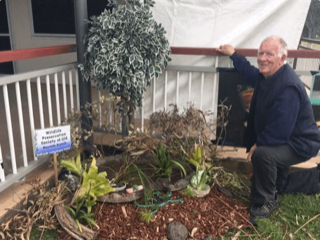21 August 2020
Wildlife Queensland Bayside Branch was thrilled to be a special guest presenter at Redland Museum’s annual Science Fun Day this month.
At the ‘Deep Blue’ themed public event, held on 10 August, the Redland City Ekka Public Holiday, Wildlife Queensland Bayside Branch President Steve Homewood demonstrated how to build a simple frog pond to a sold-out crowd of 170 community members.
“Everyone had a fantastic time and learnt some easy and inexpensive ways to create a frog-friendly backyard and the importance of not using chemicals in gardens,” says Steve Homewood.
“We had lots of very excited kids at our demonstration, keen to know how to build a frog pond and bring frogs to their backyards.”
“This is a great project for kids and a wonderful, easy way to increase the natural environment in your garden. All you need is a spare corner or spot in your backyard and a few basic low-cost (or no-cost recycled) materials.”
“Thank you to the Redland Museum for inviting Wildlife Queensland to be part of such a well-organised, educational event in celebration of National Science Week.”
Read on to find out how you can easily (and inexpensively) build a frog pond this weekend! You can also download the PDF guide here.
Frogs in your backyard
(by Wildlife Queensland Bayside Branch)

Frogs are disappearing from our backyards for many reasons, mainly from lack of water in which to breed, the overuse of pesticides and the cultivation of gardens. In order to bring those night sounds back we need to improve the habitat, by returning it to a more frog-friendly state.
Ways in which you can do this are:
- Stop using pesticides and allow natural pest controllers to do their job. Frogs and birds will eat insects, blue tongue lizards will dispose of those snails and do you know that the small insectivorous bats will eat their weight in mosquitoes.
- Plant a number of native shrubs and grasses and leave the litter from them lying on the garden. These will provide hiding places for your frogs as well as food.
- Build a simple frog pond.
Creating a pond
Materials:
The pond can be fibreglass, plastic, an old bath or sink, in fact, any container as long as it is not metal as this could leach into the water. It needs to have a deep part, at least 40cm deep but preferably around 50cm. This keeps parts of the pond cooler in the summer months.
For preference use Builders Plastic (3×2 metres) bought from a hardware store to create an inexpensive freeform pool.
Location:
- Your frog pond needs to be in an area that is in 50 per cent shade for most of the day.
- Build it away from the house, and particularly away from your neighbours’ houses, as male calling frogs can be quite noisy.
- The area should be well mulched and protected from larger birds by offering plenty of groundcover.
Building instructions:
Step 1. Double over the plastic and lay it on the ground to get the general idea of size and shape.
Step 2. Dig a hole that is at least 50cm deep at one end with a shelf that is around 10cm deep, which leaves an overlap of around 15cm. You do not need to be exact, as excess will be hidden under the mulch. The other end should gradually slope to the edge, this gives breeding areas and ease of access for the ground frogs.
Step 3. The sides will remain steep, flatten the bottom of your pond and remove anything sharp, line the base of the pond with sand, soil that has been sieved or even newspapers to avoid the lining being punctured.
Step 4. Next, put in your doubled plastic, let the excess hang over the edges, fill with tap water and let the weight of the water mould the plastic into the shape of the pond. The water will be suitable for frogs in five days once the chlorine in the water has dissipated.
Tips:
- Normally there is no need to trim the plastic, just start “landscaping” your pool by burying the plastic under the mulched edges, rocks, rotting logs driftwood etc.
- Native grasses can be planted through holes pierced in the plastic or amongst the rocks.
- The whole area around your pond should then be mulched which should also deter toads.
- The same effect can be created when using other materials to create your frog haven, the possibilities are endless, whether you use the liner or a ready-made pond.
Habitat
Frogs need plenty of mulched areas, shade, no pesticides, areas of humidity, (rotting logs, compost heap) and natural cover. Pets, especially cats, should be discouraged from visiting the area.
Water plants
There are a variety of native plants that can be utilised for your pond – Kangaroo Grass, Sedge, Lomandra and Melastoma Affine. Avoid noxious weeds like salvinia and water lettuce that are often found in our waterways and seek native or compatible plants from your local nursery. Experiment with garden plants in soil in a pot in the water.
Mosquitoes
A pond that is in good condition will not attract mosquitoes, but if you are worried, introduce our native Pacific Blue Eyes, 6-8 would be enough, and they breed very well. They are available from good pet shops. Do not collect fish from creeks as they will probably eat your tadpoles and do not introduce Goldfish.
Feeding tadpoles
When your pool is new and the plants and waterweed are not yet established, you can feed your frogs and tadpoles twice a week on boiled lettuce, which can be frozen in ice-cube containers for easy storage. Later with all the leaf matter that falls into your pond from the overhead vegetation, tadpoles should have sufficient food to sustain them.
Good luck with your pond!
Experiment, try different shapes and plants, and maybe put in some low-level lighting and a small irrigation system to keep the area damp. Remember we are trying to attract frogs to our garden. Do not bring in tadpoles from another location as this has proved to be detrimental to the local frog populations.
More information
For more information on what you can do to help conserve frog habitats:
- How to build a frog hotel
- Queensland frogs – just hanging on
- FrogID: The Australian Museum’s FrogID helps you identify and record frog calls
- iNaturalist: Become a citizen scientist, record your nature observations and share with other naturalists

